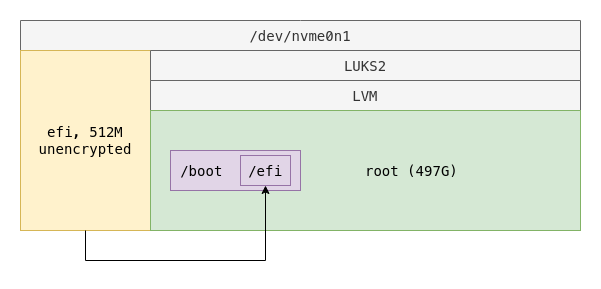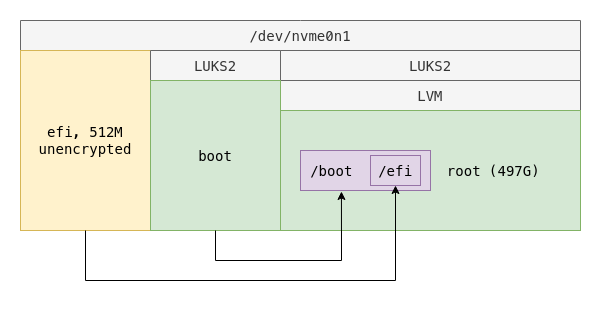- Published on
Disk Encryption on Arch
- Authors

- Name
- Furkan Er
- @erfur_qwe
Table of contents
- How to go about encrypting the whole disk
- Keep a seperate boot partition on LVM with LUKS1
- Keep a seperate boot partition on LVM but with LUKS2
- Keep boot as a folder in root partition
- How not to compromise the security of root without compromising the convenience on boot
- What about swap?
- EFI partition
I've been using linux on my computers since highschool. Though only in the recent years I made a resolution to up my security game and implement some sort of disk encryption. The arch wiki is famous for providing massive amount of knowledge but that sometimes also means getting overwhelmed in the way. And thats exactly what happened to me in my last try; I had to jump between pages for days until I was finally able to finalize how I wanted to shape my partitioning and encryption.
Previously I had left my boot partition unencrypted. This is not a serious issue at first glance. Though it's still a good idea to keep it encrypted as it houses the initramfs and the boot parameters, with which it is really trivial for a capable attacker to set you up with a backdoored system [1][2].
The reason for this post is to explore some of the possible ways of how to set up a (nearly) full-disk encryption. This includes the boot partition, the root, the home and the swap. Currently there is no support for an encrypted EFI partition so that has to be left unencrypted unfortunately.
How to go about encrypting the whole disk
There are a number of facts that will determine how to set up the partitioning and the encryption:
- The most recent GRUB version does not support the latest default dm-crypt mode that is LUKS2-Argon2 [3].
- Encrypted boot partition (if kept in a seperate luks partition) will require a second unlock with password entry to get mounted after boot.
- Boot doesn't have to be set up as a partition, instead can be created as a folder in the root partition. Though that in itself causes an interesting conundrum which I will explain later.
- Swap also does not have to be a partition. Having swap as a file does not cause any issues when used for hibernation.
- Argon2 is more resistant to cryptographic attacks than PBKDF2 [4].
Let's go through some of the scenarios that I considered.
Keep a seperate boot partition on LVM with LUKS1

The latest grub 2:2.06.r261.g2f4430cc0-1 (as of writing this post) on arch repositories does not support:
- Handling partitions encrypted using Argon2 algorithm.
- Generating a grub efistub that can handle LUKS2 partitions with
grub-install.
With these in mind, if you want to stick with the main repository and not deal with any custom parameters or hacks, it is possible to encrypt the boot partition using LUKS1 mode:
cryptsetup luksFormat --type luks1 --pbkdf-force-iterations=500000 /dev/nvme0n1p2
The default iteration count for pbkdf2 algorithm (which is the default algorithm when luks1 is used) will be too high because of the fact that the iteration count. Since the benchmark is (probably) done with the full resources of the computer and grub environment will be constrained in terms of resources (cpu and memory capabilities), the time to unlock will be far from optimal. Hence it is advised to use a lower iteration count to be able to unlock the disk on boot within a reasonable timeframe. Though this is an obvious tradeoff, compromising security for convenience.
Apart from having to explicitly use two parameters in cryptsetup calls, the rest of the procedure goes on without a detour. Here's how I did it:
# create physical partitions
# nvme0n1p1: efi
# nvme0n1p2: boot
# nvme0n1p3: root
echo -e "size=512M, type=U\n size=512M, type=L\n size=+, type=L\n" | sfdisk /dev/nvme0n1
# format the efi partition
mkfs.fat -F 32 /dev/nvme0n1p1
# format the boot partition
cryptsetup luksFormat --type luks1 --pbkdf-force-iterations=500000 /dev/nvme0n1p2
cryptsetup open /dev/nvme0n1p2 boot
# keep the partition directly on top of LUKS
mkfs.ext4 /dev/mapper/boot
# format the root partition
cryptsetup luksFormat /dev/nvme0n1p2
cryptsetup open /dev/nvme0n1p2 netwalkerfs
# create the logical root partition
pvcreate /dev/mapper/netwalkerfs
vgcreate netwalkerfs /dev/mapper/netwalkerfs
lvcreate -l 100%FREE netwalkerfs -n root
mkfs.ext4 /dev/netwalkerfs/root
# mount them all
mount /dev/netwalkerfs/root /mnt
mkdir -p /mnt/boot
mount /dev/mapper/boot /mnt/boot
mkdir -p /mnt/boot/efi
mount /dev/nvme0n1p1 /mnt/boot/efi
# ready to proceed
# dont forget to set up:
# mkinitcpio hooks
# grub cryptodisk support
# grub cryptodisk parameter
Keep a seperate boot partition on LVM but with LUKS2

Formatting the encryption partition with LUKS2 does not require anything extra, meaning that the previous code with only the luksFormat line modified will work just fine:
cryptsetup luksFormat /dev/nvme0n1p2
Unfortunately LUKS2 mode also suffers from the previously mentioned boot time issue where it will take a long time to unlock the partition on boot with the default parameters. Still, since Argon2 is a stronger algorithm, decreasing the iteration time (which is used to run a benchmark to set the iteration count to match the given time) will still result in a better protected filesystem than LUKS1.
# decrease iteration time but increase the key size
cryptsetup luksFormat --iter-time 200 --key-size 512 /dev/nvme0n1p2
Another issue is that, to be able to boot from the encrypted partition a patched version of grub that supports Argon2 is required, though fortunately it's already packaged and ready to be installed in AUR [5]. Still, note that the package has other AUR dependencies so I advise installing an AUR helper first then installing the package through the helper. I'm using paru and paru does not install aur packages as root, so I create my user first then use paru with sudo:
useradd -m -G wheel -s /bin/bash erfur || info "already exists."
echo "erfur ALL=(ALL:ALL) ALL" >> /etc/sudoers
passwd erfur
cd /tmp
pacman -S --noconfirm git
sudo -u erfur git clone https://aur.archlinux.org/paru-bin.git || info "folder exists."
cd /tmp/paru-bin
sudo -u erfur makepkg -si
sudo -u erfur paru -S --noconfirm grub-improved-luks2-git efibootmgr lvm2
After this the installation continues as usual.
Keep boot as a folder in root partition
The previous scenarios work reasonably well but there is nothing gained (at least none in my case) in keeping boot as a partition when it sits on the same LUKS partition as root. The patched version of grub can access /boot just the same. This approach simplifies the partition layout:

Without having to create a boot partition, we are left with a shorter code:
# create physical partitions
# nvme0n1p1: efi
# nvme0n1p2: root
echo -e "size=512M, type=U\n size=+, type=L\n" | sfdisk /dev/nvme0n1
# format the efi partition
mkfs.fat -F 32 /dev/nvme0n1p1
# format the root partition
cryptsetup luksFormat --iter-time 200 --key-size 512 /dev/nvme0n1p2
cryptsetup open /dev/nvme0n1p2 netwalkerfs
# create the logical root partition
pvcreate /dev/mapper/netwalkerfs
vgcreate netwalkerfs /dev/mapper/netwalkerfs
lvcreate -l 100%FREE netwalkerfs -n root
mkfs.ext4 /dev/netwalkerfs/root
# mount them all
mount /dev/netwalkerfs/root /mnt
mkdir -p /mnt/boot/efi
mount /dev/nvme0n1p1 /mnt/boot/efi
# ready to proceed
# dont forget to set up:
# mkinitcpio hooks
# grub cryptodisk support
# grub cryptodisk parameter
How not to compromise the security of root without compromising the convenience on boot
It is possible not to let the two affect each other by having boot and root on seperate luks partitions. The root partition can be created with default parameters while the boot partition can be created with a lower iteration time which will still be reasonably effective and not unbearably slow.

Since boot is a single partition on luks, there is no need to add an lvm layer there. The same can also be said for the root partition in this specific case but I added lvm just in case.
Here's the code to achieve this scheme:
# create physical partitions
# nvme0n1p1: efi
# nvme0n1p1: boot
# nvme0n1p2: root
echo -e "size=512M, type=U\n size=512M, type=L\n size=+, type=L\n" | sfdisk /dev/nvme0n1
# format the efi partition
mkfs.fat -F 32 /dev/nvme0n1p1
# format the boot partition
cryptsetup luksFormat --iter-time 200 --key-size 512 /dev/nvme0n1p2
cryptsetup open /dev/nvme0n1p2 netwalkerfs
# create the logical root partition
pvcreate /dev/mapper/netwalkerfs
vgcreate netwalkerfs /dev/mapper/netwalkerfs
lvcreate -l 100%FREE netwalkerfs -n root
mkfs.ext4 /dev/netwalkerfs/root
# format the root partition
cryptsetup luksFormat --iter-time 200 --key-size 512 /dev/nvme0n1p2
cryptsetup open /dev/nvme0n1p2 netwalkerfs
# create the logical root partition
pvcreate /dev/mapper/netwalkerfs
vgcreate netwalkerfs /dev/mapper/netwalkerfs
lvcreate -l 100%FREE netwalkerfs -n root
mkfs.ext4 /dev/netwalkerfs/root
# mount them all
mount /dev/netwalkerfs/root /mnt
mkdir -p /mnt/boot/efi
mount /dev/nvme0n1p1 /mnt/boot/efi
# ready to proceed
# dont forget to set up:
# mkinitcpio hooks
# grub cryptodisk support
# grub cryptodisk parameter
The caveat here is that since boot is in a seperate encrypted partition, it will require a second unlock after unlocking the root partition if the boot partition is configured to automount (added into /etc/crypttab), resulting in three consecutive password prompts. This can be solved using keyfiles:
- The root partition can be automatically unlocked using a keyfile kept in the initramfs or the boot partition [6][7].
- The boot partition can be automatically mounted after boot using a keyfile kept in the root filesystem.
Applying both of these will reduce the number prompts to just one, on the other hand the keys will be accessible while the partitions are mounted. It is a significant tradeoff to consider.
What about swap?
Since swap can be set up as a file in the root partition [8], I did not include it until now. It takes a few steps to set up a swapfile and these steps can be included in any of the previous scenarios:
# create swapfile (40GiB in my case)
dd if=/dev/zero of=/swapfile bs=1G count=40 status=progress
# only root should have access
chmod 0600 /swapfile
# format for swap
mkswap -U clear /swapfile
swapon /swapfile
# add to fstab
echo "/swapfile none swap defaults 0 0" >> /etc/fstab
# add necessary parameters to the grub config
swap_offset=`filefrag -v /swapfile | awk '$1=="0:" {print substr($4, 1, length($4)-2)}'`
# resume should point to the logical partition
sed -i "s|^GRUB_CMDLINE_LINUX=.*|GRUB_CMDLINE_LINUX=\"resume=/dev/netwalkerfs/root resume_offset=$swap_offset\"|g" /etc/default/grub
EFI partition
It is not quite possible to call it a full-disk encryption while the EFI partition is unencrypted. Do not fret, as modern cryptography is here to compensate. It is possible to roll grub with secure boot to ensure the integrity of the efistub. Though I'm currently not using it, I'll surely implement it someday.
This post has been written in a very short span of time, which is surprising to me. I did not intend to paint a complete picture here, hence only partial codes to achieve the specific partitioning schemes. I'm currently in the process of converting my installation scripts to ansible playbooks, after that I might release them.